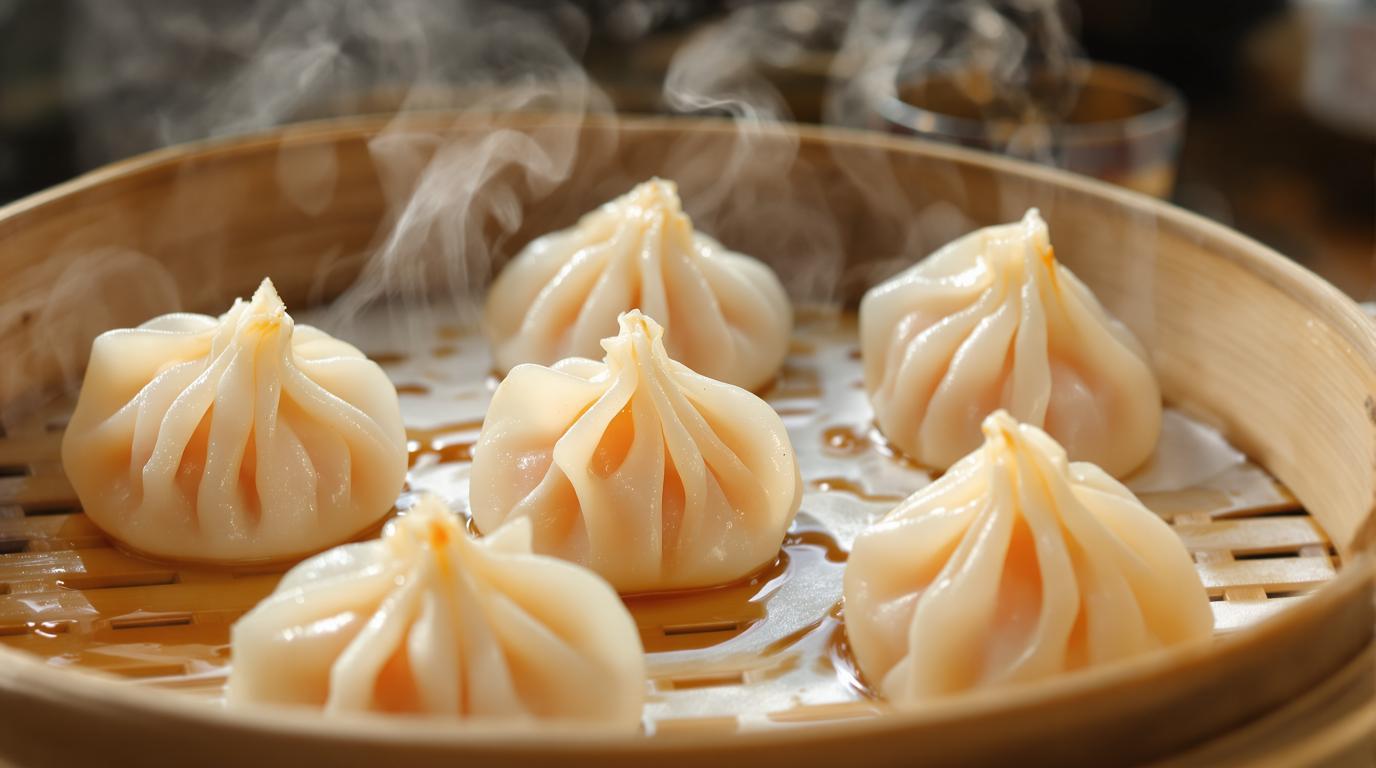The first time I crafted har gow dumplings was during my early apprenticeship in Hong Kong. I spent three months practicing the pleating technique before my mentor would even let me serve them to guests! These translucent shrimp dumplings are considered the crown jewel of dim sum, with their delicate wrappers revealing the pink treasures within. A skilled chef is often judged by the quality of their har gow—the wrapper should be thin yet strong, with at least 7 pleats per dumpling. Today, I’ll share my authentic recipe that brings restaurant-quality har gow to your home kitchen. 🥟
The Story Behind Crystal Shrimp Dumplings 📖
Har gow originated in Guangzhou, China nearly 200 years ago in teahouses along the Pearl River. The translucent wrapper was designed to showcase the quality of the shrimp inside—a luxury ingredient that signified prosperity. What most people don’t realize is that the wrapper contains no gluten at all, relying instead on the unique properties of wheat starch and hot water to create its characteristic texture. When I visited dim sum masters in Guangdong Province, they shared that the mark of excellence is a wrapper so thin you can read a newspaper through it, yet strong enough to hold its shape during steaming. 🇨🇳
Essential Ingredients 🧾
For the crystal wrapper (makes about 20 dumplings):
- 1 cup (100g) wheat starch (not wheat flour)
- 1/4 cup (50g) tapioca starch (provides elasticity)
- 1/4 teaspoon kosher salt
- 1 tablespoon vegetable oil
- 3/4 cup (180ml) boiling water (exact temperature is crucial)
For the filling:
- 12 oz (340g) raw shrimp, peeled and deveined
- 2 oz (55g) bamboo shoots, finely diced
- 1 tablespoon finely minced pork fat (optional but traditional)
- 1 teaspoon grated fresh ginger
- 1 tablespoon Shaoxing wine
- 1 teaspoon oyster sauce
- 1/2 teaspoon sesame oil
- 1/4 teaspoon white pepper
- 1/2 teaspoon sugar
- 1/2 teaspoon salt
- 1 teaspoon cornstarch (binds the filling)
Chef’s Note: The wrapper’s success hinges entirely on using wheat starch (not wheat flour) and truly boiling water. The intense heat gelatinizes the starches immediately, creating that signature chewy-yet-tender texture. Water that’s merely hot won’t activate the starches properly, resulting in a wrapper that tears.
Step-by-Step Instructions 📝
Prepare the filling:
- Chop 2/3 of the shrimp into small pieces (about 1/4 inch), leaving 1/3 of the shrimp in larger chunks for texture. This dual-texture approach provides the perfect bite. 🔪
- Mix all filling ingredients in one direction (clockwise only) until slightly sticky and well-combined. This creates the bouncy texture prized in traditional har gow.
- Cover and refrigerate for 30 minutes to marry the flavors while you prepare the dough.
Make the wrapper dough:
- Combine wheat starch, tapioca starch, and salt in a heat-resistant bowl.
- Add oil, then pour in boiling water while stirring vigorously with chopsticks or a wooden spoon.
- Once cool enough to handle, knead for 2-3 minutes until smooth and pliable. The dough should be soft but not sticky—it should pull away cleanly from the bowl.
- Cover with a damp cloth to prevent drying while you work. This is absolutely essential as the dough dries quickly!
Form the dumplings:
- Divide dough into 20 equal pieces (about 15g each). Keep covered except for the piece you’re working with.
- Press each piece into a disc, then roll into a 3.5-inch circle, keeping the edges thinner than the center.
- Place a tablespoon of filling in the center.
- Pleat one side of the wrapper, making 7-10 small folds while leaving the other side smooth. This creates the traditional crescent shape.
- Press gently to seal completely.
Chef’s Secret Techniques 🤫
The texture of perfect har gow relies on technique, not just ingredients. Cut your shrimp against the grain for tenderness. When mixing the filling, always stir in one direction only—this aligns the proteins and creates that coveted bouncy texture that marks authentic dim sum.
For the wrapper, I keep a small bowl of room-temperature water nearby. If the dough cracks at the edges while rolling (which happens if it’s too dry), I dip my fingertip in water and repair the crack. But avoid getting the edges wet when pleating, as moisture prevents proper sealing.
If you can’t find wheat starch, you can substitute a mixture of cornstarch (70%) and tapioca starch (30%), though the texture won’t be quite the same. The resulting wrapper will be slightly more delicate, so handle with extra care. 🔄
Serving & Presentation Tips 🍽️
Steam the dumplings for exactly 6 minutes in a bamboo steamer lined with parchment paper or cabbage leaves to prevent sticking. Serve immediately—har gow wait for no one! The classic dipping sauce is simply good-quality light soy sauce with a few drops of chili oil, though purists believe the best har gow needs no sauce at all.
In traditional dim sum houses, har gow is often served alongside other layered delicacies, forming a symphony of textures. These dumplings pair beautifully with a light jasmine tea or, for special occasions, a glass of dry Gewürztraminer or Viognier.
While making har gow requires patience, the results connect you to centuries of culinary tradition. Like these cream puffs or puff pastry pinwheels, mastering this technique opens doors to countless variations. You might even try incorporating flavors from Malaysian curry or French stew techniques for fusion creations.
Remember, your first batch may not be perfect—mine certainly wasn’t! But each dumpling gets better, and the moment you bite into that tender wrapper revealing juicy shrimp within, you’ll understand why har gow has been captivating diners for generations. ✨
